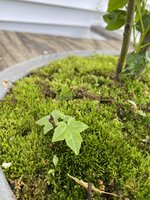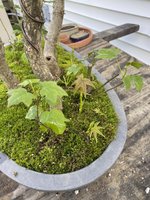I've been thinking a lot about this arrangement lately. In part, I'm glad I was able to find some material with good roots, and I do like the direction this new forest is going. Fingers crossed that these trees all recover swiftly. Hopefully, I can quickly thicken a few of them up just a little bit by letting them grow. Still, I'm a disappointed that the bigger trees didn't make it and that I had to replace them with smaller trees with less interesting movement.
Regarding why some of the trees died, I was already well aware that, for example, beeches and pines hate root work. However, I was under the false impression that sweetgum would be more forgiving. Relevantly, I think of beeches as sensitive to disturbance because they're a "climax community" tree in terms of ecological succession in disturbed areas. I still believe this is partly true—and also why, with patience, they make excellent specimen trees. By contrast, "pioneer species" like mulberries love to shoot up in cleared areas. They aren't demanding in terms of soil quality, humidity, etc. They just love to get lots of sunlight. Northern red maples fill a similar role, as do sycamores (along stream banks) and tulip poplars. Sweetgum also fills this role.
Accordingly, I expected all of the trees I collected to be as hardy as similarly-situated maples, sycamores, and tulip poplars. The field trees met my expectations. The ones collected from the forest did not. They had all grown from suckers on more mature trees, and, lacking roots, they ran out of energy by mid summer and died over the winter. Maples I had collected nearby came, in a few cases, without any feeder roots. I chopped the trunks, chopped the thick roots, and put the stumps in pots. All quickly rooted and are still alive. I've had similar success with ironwoods (what some of you heathens call "American hornbeam"). No roots necessary. So long as I have the root collar, it'll work like a giant cutting, even without a greenhouse to keep in the humidity. Just shade. The sweetgums were not so forgiving.
The seedlings I collected from the field all had great roots. Shallow, with feeders close to the trunk. They all survived. The forest "seedlings" I collected were not seedlings at all, but suckers, as previously mentioned. They soon withered. They tried to send out a second flush of growth after the first shriveled up, but they couldn't recoup enough energy to survive the winter. The suckers were accustomed to drawing energy from the parent plant, and they could not survive when separated. It's the same as with beech.












